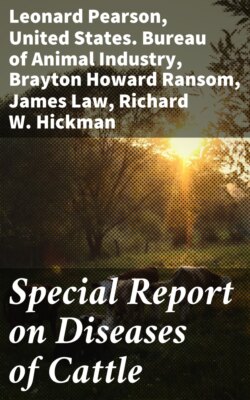Читать книгу Special Report on Diseases of Cattle - Lowe - Страница 134
На сайте Литреса книга снята с продажи.
PNEUMONIA.
ОглавлениеPneumonia is an inflammation of the lung substance, and is divided into three forms, viz, croupous, catarrhal, and interstitial. These various forms, however, can be differentiated only by the expert, and it is therefore deemed necessary for the purpose of the present work to treat the subject under the general head of pneumonia.
The causes of pneumonia in general are the same as those of the various other inflammatory diseases of the respiratory tract. The germ is known as a pneumococcus. The disease mostly follows congestion of the lungs, but may in rare cases have a parasitic origin.
Symptoms.—In the first stage, that of congestion, the disease is usually ushered in by a chill, although this may not always be observed by the attendant. This is followed by an elevation of temperature, usually 105° to 106° F., or it may be even higher. The respirations are quick and shallow; the nostrils are dilated; the pulse is full and hard. Cough may or may not appear in this stage. The nose is hot and dry; the tongue sometimes protrudes and is slimy; the coat is staring, and the skin dry and harsh. The urine is usually diminished in quantity, high colored, and the bowels constipated. The animal stands with the forelegs wide apart to facilitate respiration. On auscultation crepitation will be observed over the portion of the lung affected. The sounds elicited on percussion are practically normal in this stage.
In the second stage the temperature generally drops one or two degrees, and respiration is performed with much difficulty. The cough is frequent and painful. The animal still stands with the forelegs wide apart and the elbows turned outward. If it assumes the recumbent position it rests on the sternum. All secretions are more or less suspended, particularly the milk in cows. The animal has a haggard appearance, and the pulse becomes small and wiry at this period. The extremities are hot and cold alternately; the crepitation which was present in the first stage is now absent, and no sound on auscultation is heard, unless it is a slight wheezing or whistling noise. On percussion dullness over the diseased lung is manifested, indicating consolidation. The lung has now assumed a characteristic liverlike appearance.
In the third stage, if the disease is to terminate favorably, the cough becomes loose, the animal improves, the appetite returns, and the symptoms above detailed rapidly subside; if, on the other hand, resolution is not progressing, the lung substance degenerates, becomes clogged up, and ceases to function. In fatal cases the breath has a peculiar, fetid, cadaverous odor, and is taken in short gasps; the horns, ears, and extremities become cold and clammy, and the pulse is imperceptible. On auscultation, when suppuration is taking place and the lung structure is breaking down, a bubbling or gurgling crepitation, caused by the passage of air through pus, is heard.
Treatment.—Good hygienic surroundings and good nursing are essential in connection with the medical treatment. The probability of recovery depends largely on the extent of the lung tissue involved, as well as on the intensity of the inflammatory process. In the early stage, when the fever is high, febrifuges should be given. If the pulse be strong and full, aconite (Fleming's tincture, 1 to 2 drams, every four or five hours) may be given for a short time, but should be discontinued as soon as the fever begins to abate. Aconite is a valuable drug in the hands of the intelligent practitioner, but my experience leads me to believe that not infrequently animals are lost by its injudicious use, for in many febrile conditions it is positively contraindicated, owing to its action upon the heart. In a plethoric animal, with a strong, bounding pulse, bleeding may be resorted to instead of administering aconite. If the bowels are constipated, calomel, 1 to 3 drams, which acts as a cathartic and a febrifuge, is advisable. In the second stage diffusible stimulants are required, viz: Spirits of nitrous ether, 2 ounces; aromatic spirits of ammonia, 1 ounce; mix, and give in gruel three times daily. In some cases carbonate of ammonia, 2 to 5 drams, has been found beneficial. Most practitioners apply counterirritants, such as mustard plasters, turpentine, and ammonia liniment, or cantharides.
